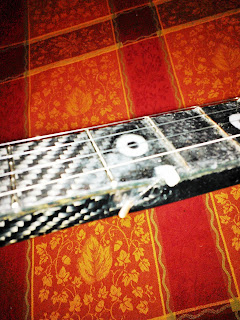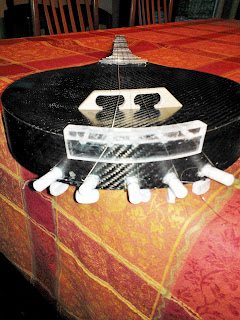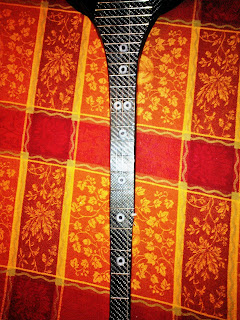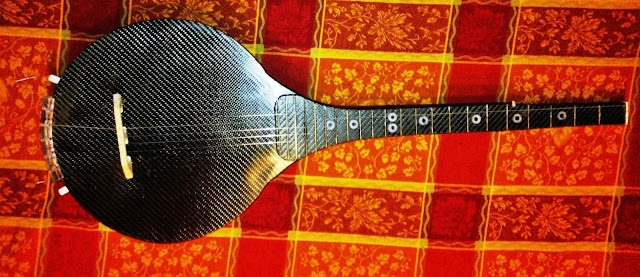 |
| Headless Head |
The G4 string at the 5th fret is attached to the neck with a copper peg. The string feeds over a piece of nylon washer shaped to fit into a hole drilled behind the fifth fret. The out-hanging nylon has a grove cut into it to align the string at its proper spacing and to head it in the right direction over the fretboard.
 |
| G4 String Peg |
I used five old guitar tuners for the rear mounted adjustments. There was difficulty bringing the strings straight down off the back of the soundboard. I went through a couple of versions of transition bridges before I settled on making one out of Plexiglas. The Plexiglas was heated and formed to the shape and then drilled at the angle the string would take to its tuner. This method relieved a lot of string sheering tension.
 |
| Rear Tuners |
What to do for fret inlays? My fretboard is 1/8th inch thick. This limited me to what I could use. While trolling the Ace Hardware store I came upon a tray of nylon washers where I found some that were 1/8 x 3/8 inch in size. I picked up a tube of liquid metal to fill in the centers after the mounting glue had dried. My black felt tip marker did the rest.
 |
| Fret Inlays |
The soundboard is a single layer of 3.5 ounce carbon fiber twill fabric. The soundboard also forms the initial cover for the neck. There was concern about not having a means of stretching the soundboard, as is done for conventionally covered banjo jugs. Naturally, once cured the carbon fiber is not going to stretch, so the concern was fruitless. The soundboard was resin attached to the level sanded jug and neck. It is going to be what it is. A couple of bridges were tried before settling on the one shown. The height of the bridge is important in creating the necessary gap between the frets and the strings. I turns out that even though the soundboard doesn't stretch, it does concave under pressure. Three pieces of carbon arrow shafts were glassed into the ring before the soundboard was attached. The purpose of the shafts is to maintain the circular shape when the ring is put under the tremendous warping tension when the strings are tightened. This they do well. What wasn't initially thought of was the fact that the string tension would tend to pull the bottom edge of the ring away to the rear. This created a desire for the soundboard to wrinkle and thus lower the resting plane of the bridge. A strip of brass and a turnbuckle to the rescue. These were added to the bottom of the ring to counter the motion of the bottom of the ring. The turnbuckle, although not pleasant to look at, provides the correct amount of adjust ability to the counter-tension. The bridge once again rides where it should in relation to the frets; 5/8th inch is a standard height.
 |
| Counter Tension Devices
|
 |
| Finished Banjo |

No comments:
Post a Comment